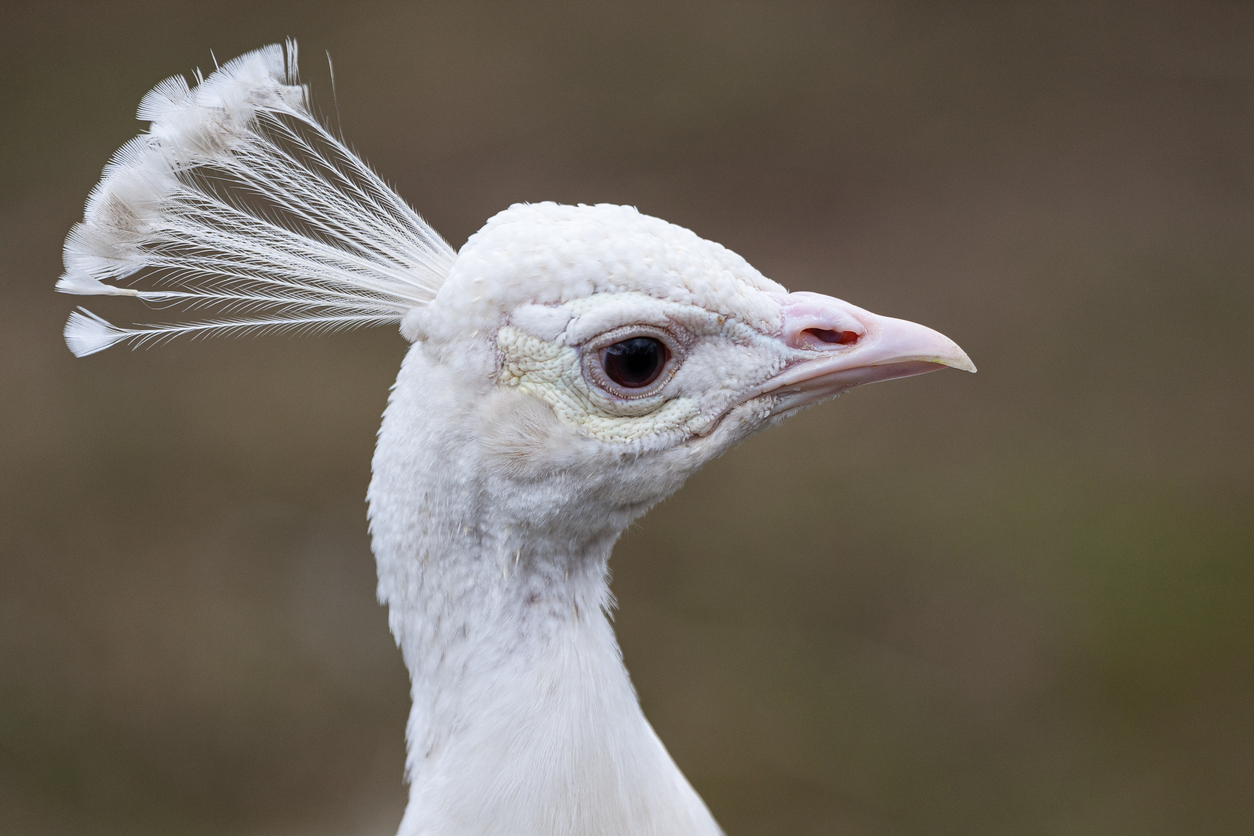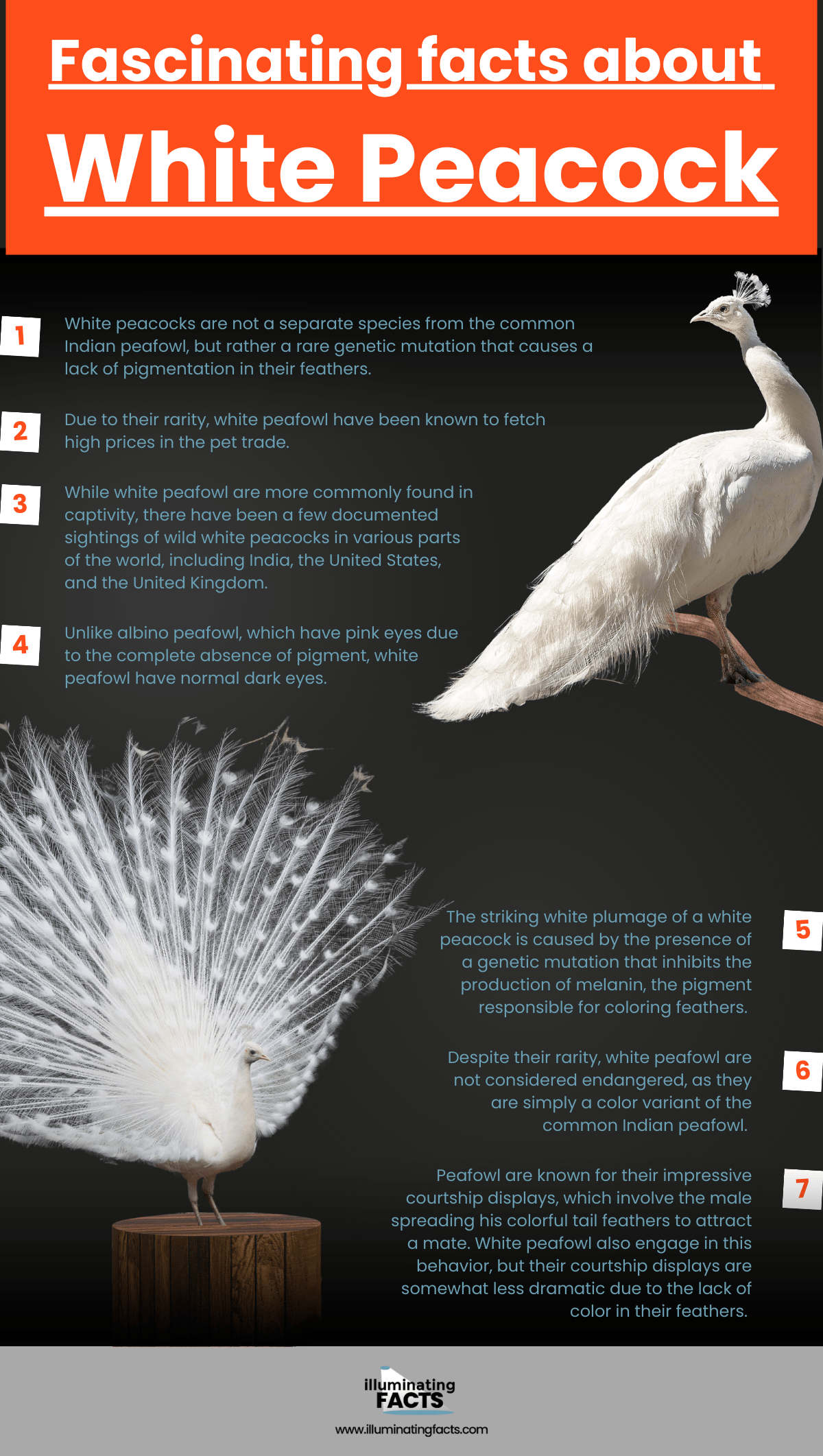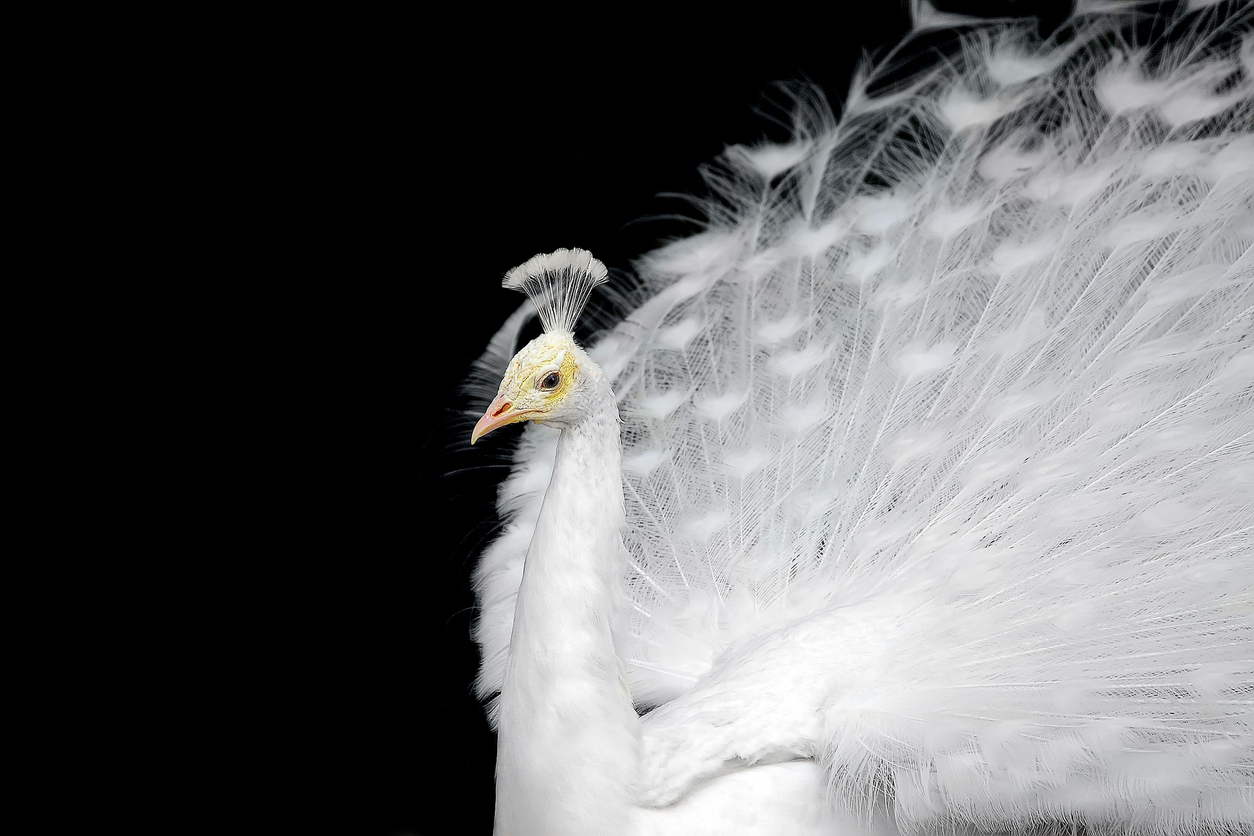Table of Contents
Peacocks are majestic birds renowned for their vibrant plumage and ornate tail feathers. They are an enduring symbol of beauty, grace, and pride, inspiring countless works of art and literature throughout history. But have you ever heard of a white peacock?
Despite being less common than their colorful counterparts, white peafowl are a stunning sight to behold. Their snowy white feathers are a rarity in the animal kingdom, and their graceful movements and striking features can leave a lasting impression on those who see them.
But how often do white peafowl occur in the wild or in captivity? And what makes them different from other peafowl? In this article, we’ll delve into the world of white peafowl and explore the fascinating science behind these magnificent birds.
General overview of peacocks
Peacocks, also known as peafowl or peahens, are members of the pheasant family that are native to Asia. There are three species of peacocks: the Indian peacocks (Pavo cristatus), the Green peacocks (Pavo muticus), and the Congo peacocks (Afropavo congensis). [1] The Indian peacocks is the most widely known and recognized, and is the only species that is commonly kept in captivity.
Male peacocks are famous for their iridescent plumage, which is composed of long, colorful feathers that form a fan-like shape around their tails. These feathers are used during courtship displays to attract females and intimidate rivals. In contrast, female peafowl have a more muted coloration, with brown or grey feathers that help them blend into their surroundings while they care for their young.
Peacocks are social animals that are often found in small groups known as parties or prides. [2] They are omnivorous and eat a diverse food that includes small mammals, reptiles, insects, and seeds. These birds can also adapt to a range of habitats, including forests, grasslands, and agricultural fields.
In captivity, peacocks can make charming and entertaining pets, although they require specialized care and attention. They need ample space to roam and access to fresh food and water at all times. They also need protection from predators, including dogs, cats, and birds of prey.
Overall, peacocks are fascinating creatures that have captured the hearts and imaginations of people around the world. Whether admired for their stunning beauty or appreciated for their curious behaviors, these birds are a true wonder of the natural world.
Leucism or Albino: What is the difference?
Peacocks are known for their colorful plumage, which ranges from bright blues and greens to deep purples and bronzes. However, sometimes they are born with a genetic mutation that alters their pigmentation, resulting in birds with white feathers. But are all white peacocks the same, or do they come in different shades? And how do we tell the difference between leucism and albinism?
Leucism is a condition that affects the production of melanin, the pigment responsible for the coloration of feathers, fur, and skin in many animals. Leucistic peacocks have a reduced amount of melanin, which can result in patches of white, cream, or pale brown feathers on an otherwise normal-looking bird. In contrast, albino birds have a complete absence of melanin, which makes them completely white, with pink eyes and bills. [3]
According to the San Diego Zoo directory, white peacocks are usually the result of leucism rather than albinism. [4] Leucistic peafowl retain some of their original pigmentation, which can result in subtle variations in their feathers, such as patches of pale blue or green. In contrast, albino peafowl are extremely rare, with only a handful of documented cases worldwide.
However, it’s important to note that white peacocks can also occur due to selective breeding. Some breeders prefer white peafowl for their unique beauty and rarity, and have deliberately bred peafowl with white plumage to create a more consistent population of white birds.
One example of a white peafowl that has captured the internet’s attention is the albino peacock owned by the Northern Nester blog. This bird, named Snowflake, is a stunning example of an all-white peafowl, with pure white feathers and striking pink eyes. Snowflake has become something of a local celebrity in his hometown, where he is known for his regal bearing and calm demeanor.
Whether leucistic or albino, white peacocks are a rare and beautiful sight that inspires awe and admiration. Their unique appearance and striking features make them a true wonder of the animal kingdom.
Habitat
Peafowl are native to Asia, where they inhabit a range of habitats, from dense forests to open grasslands. However, in many parts of the world, peafowl have been introduced as ornamental birds or agricultural pests, and can be found in parks, gardens, and farms.
When it comes to white peafowl, their habitat requirements are no different from those of their colorful counterparts. White peafowl need access to fresh water and a varied diet of seeds, insects, and small animals. They also require ample space to roam and forage, as well as shelter from extreme temperatures and predators.
However, the odds of finding a white peacock in the wild or in a naturalized setting are extremely low. As we’ve seen, most white peafowl are the result of selective breeding by humans, and are kept in captivity or as ornamental birds. While white peafowl can technically survive in the wild, their bright white coloration can make them an easy target for predators, as they are more visible than their brown or green counterparts.
In fact, according to a study published in the scientific journal PLOS One [5], white peafowl are more vulnerable to predation than their colorful counterparts. The study found that white peafowl were more likely to be attacked by predators such as foxes, dogs, and birds of prey, and that they spent more time hiding and less time foraging than their colorful counterparts.
This means that the odds of finding a white peacock in the wild are extremely low, and that most sightings of white peafowl are likely to occur in captive or domesticated settings, such as zoos, parks, or private collections. However, if you are lucky enough to come across a white peafowl in the wild, it’s sure to be a rare and memorable experience.
Breeding and Genetics
Peacocks are known for their extravagant displays of feathers during mating season, which can include fluffing up their feathers and making loud vocalizations to attract females. In the wild, peafowl mate between April and June, with males engaging in elaborate courtship rituals to impress females.
Breeding peafowl in captivity has led to a wide range of colors and patterns, including white peafowl. While white peafowl are often referred to as “albino,” they are actually a result of a genetic condition called leucism, which causes a loss of pigmentation in feathers but does not affect the eyes. Albino birds, on the other hand, lack all pigmentation, including in their eyes.
Breeding for specific colors and patterns in peacocks is a complex process that involves understanding the genetics of feather pigmentation. Recent research has shed light on the genes responsible for feather pigmentation in peafowl, including the MC1R gene, which regulates the production of melanin. [6] Scientists have also discovered a range of genetic mutations that can lead to unusual colorations, such as the “spalding” mutation that produces a mix of white and brown feathers.
The odds of finding a white peacock in the wild due to natural selection and genetic mutations are extremely low, as most white peafowl are the result of selective breeding by humans. However, understanding the genetics of feather pigmentation can help breeders produce a wider range of colors and patterns in captive peacock populations.
Cultural Significance
Peacocks have played an important role in human culture for centuries, particularly in Asia, where they are considered a symbol of beauty, grace, and good fortune. Peafowl have been depicted in art and literature throughout history, from ancient Greek pottery to Indian miniature paintings.
In Western culture, peafowl have also had a long and complex history, symbolizing everything from vanity and pride to resurrection and immortality. In medieval Europe, peafowl were a prized delicacy at feasts and banquets, and their feathers were used to adorn clothing and accessories. [7] Today, peafowl remain a popular ornamental bird and can be found in parks, gardens, and zoos around the world. However, their popularity has also led to problems in some areas, where peafowl have become an invasive species and a nuisance to local residents.
Despite their cultural significance, the odds of finding a white peacock in a natural or wild setting are extremely low. However, if you are lucky enough to see one, their stunning beauty and cultural significance are sure to leave a lasting impression.
Conservation Status
While peacocks are not currently considered an endangered species, some populations have seen a decline in recent years due to habitat loss and hunting. The Indian Peafowl, which is the most widely distributed peafowl species, is currently listed as of “Least Concern” by the International Union for Conservation of Nature (IUCN). [8] However, the Green Peafowl, which is found in Southeast Asia, is considered “Endangered” due to habitat loss and hunting.
Conservation efforts are underway to protect peafowl populations and their habitats, including the establishment of protected areas and the promotion of sustainable hunting practices. However, the odds of finding a white peacock in the wild are still extremely low, as these birds are generally found in captivity or in areas where they have been introduced by humans.
As awareness of the importance of peafowl conservation grows, it is hoped that these beautiful birds will continue to thrive in the wild and captivate people around the world with their stunning displays of feathers.
Fascinating facts
- White peacocks are not a separate species from the common Indian peafowl, but rather a rare genetic mutation that causes a lack of pigmentation in their feathers.
- Due to their rarity, white peafowl have been known to fetch high prices in the pet trade.
- While white peafowl are more commonly found in captivity, there have been a few documented sightings of wild white peacocks in various parts of the world, including India, the United States, and the United Kingdom.
- Unlike albino peafowl, which have pink eyes due to the complete absence of pigment, white peafowl have normal dark eyes.
- The striking white plumage of a white peacock is caused by the presence of a genetic mutation that inhibits the production of melanin, the pigment responsible for coloring feathers.
- Despite their rarity, white peafowl are not considered endangered, as they are simply a color variant of the common Indian peafowl.
- Peafowl are known for their impressive courtship displays, which involve the male spreading his colorful tail feathers to attract a mate. White peafowl also engage in this behavior, but their courtship displays are somewhat less dramatic due to the lack of color in their feathers.
Conclusion
In summary, the odds of finding a white peacock in the wild are very low, but not impossible. While these rare birds are typically found in captivity or in areas where they have been introduced by humans, there have been a few documented cases of wild white peacocks in various parts of the world.
While there are some estimates on the odds of finding a white peacock, it is important to note that there are no concrete statistics available. This is largely due to the fact that white peacocks are incredibly rare and difficult to spot in the wild. Additionally, there is still much that researchers do not know about the genetic factors that can lead to a peacock being born with white feathers.
The genetic mutation that causes white plumage in peafowl is rare, and even more so in the wild population. However, with the ongoing loss of habitat and other threats to peafowl populations, it’s difficult to predict what the future holds for these magnificent birds.
Despite the low odds of encountering a white peacock, the thrill of spotting one of these rare birds is enough to make any birdwatcher’s heart skip a beat. Whether in captivity or in the wild, peafowl continue to capture the imagination of people around the world with their dazzling displays of plumage and unique personalities.
References:
- Types of peacocks. (n.d.). Sciencing. https://sciencing.com/types-peacocks-7340346.html
- Peacock Facts & Worksheets. (n.d.). www.kidskonnect.com/. https://kidskonnect.com/animals/peacock/
- Brad. (2021, September 15). Albino peacock – What you need to know!Northern Nester. https://northernnester.com/albino-peacock/
- Peafowl. (n.d.). San Diego Zoo Animals & Plants. https://animals.sandiegozoo.org/animals/peafowl
- How conspicuous are peacock eyespots and other colorful feathers in the eyes of mammalian predators?(2019, April 24). PLOS. https://journals.plos.org/plosone/article?id=10.1371/journal.pone.0210924
- Genetic and molecular basis of feather diversity in birds. (n.d.). PubMed Central (PMC). https://www.ncbi.nlm.nih.gov/pmc/articles/PMC6171735/
- Peafowl: In history & culture. (2021, July 15). Assorted Regards. https://assortedregards.com/2021/07/15/peafowl-in-history-culture/
- The IUCN red list of threatened species. (n.d.). IUCN Red List of Threatened Species. https://www.iucnredlist.org/species/22679435/92814454




